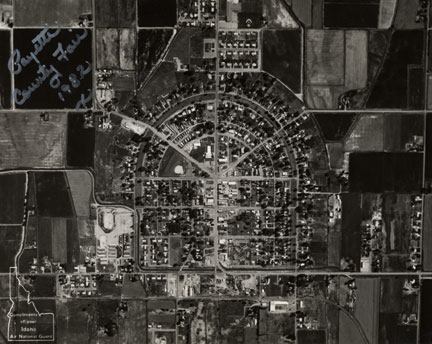A group of citizens, dissatisfied with city life in Chicago in 1895, formed what they called "The New Plymouth Society of Chicago." The farmer's irrigation promoter, William E. Smythe who was encouraging the young and old to go west and develop the country with the help of irrigation, led it.
The New Plymouth Society of Chicago selected a committee to investigate the Payette River Valley in the new state of Idaho to be purchased for the colony. It was on the drawing boards in Chicago. A committee of seven, after investigating the proposed location site, returned to Chicago with a very favorable report.
 In February 1896, it was decided that each colonist would purchase twenty shares of stock at $30 per share, which would entitle him to twenty acres of land and a town lot. He was to clear the land of sagebrush and plant fruit trees.
In February 1896, it was decided that each colonist would purchase twenty shares of stock at $30 per share, which would entitle him to twenty acres of land and a town lot. He was to clear the land of sagebrush and plant fruit trees.At the town was plotted horseshoe shape, with the open end toward the railroad and river. This area was planned as an industrial zone, and the acre tracts around the horseshoe were the residential lots.
The homes were to be built on the street side and the balance of the acre for garden and pasture for the family cattle and horses. Between the two streets on the horseshoe or "boulevard," the committee placed an eighty foot wide park, one mile and length. It was planted in grass and shade trees, which provided a place for children to play.
Plymouth Avenue, the Main Street and principal business thoroughfare, was surveyed (16 feet off the section line) down the center of the horseshoe from the railroad and the river area on the north, through the boulevard on the south.
The community was called him "The New Plymouth Farm Village" and for two years governed by a colony board of directors. Later in 1897, it was incorporated, as a village with "New Plymouth" as the name.
The Plymouth Colony, like the Plymouth of the past, was to stand for the highest ideals of freedom and independence. One clause inserted in the deeds conveying title to the property stated "Land will be forfeited to the Colony Company in case of the sole of intoxicating liquors upon any part of the premises by the owner, or his representative." They maintained that it was possible to maintain a town in good condition, without relying upon money received in liquor traffic.
The primary concern of newly farmed villages in the valley was the construction of churches and schools. For the first three years there were no children in New Plymouth.
The first public hall built was used for all public services including school and church. It was a shack, 14 x 20 feet, weather boarded on the outside with no windows. Nail pegs with rough boards placed on top served as seats. Four church denominations held services there.
A Farther Burns was the first Methodist minister, the Reverend Clemmens, a Presbyterian, then a Congregationalist and finally Baptists took their turn each Sunday to minister to their congregations. In winter, sagebrush was gathered for fuel. For evening services, people brought their kerosene lamps from home for lights. Each resident took his turn as janitor and fuel supplier.
With the influx of more people, the need arose for a new school. A large brick building was erected. Some parents complained that it was too big.
The Congregational Church was built in 1901 and on April 15, 1902 it was dedicated. The Reverend W. L. Strange gave a history of the church noting that $371 was still owed on construction costs. The collection plate was passed. The sum of $424 was collected, placing the church out of debt. The church in Orange, New Jersey presented a beautiful set of communion silver to the congregation.
Father L. C. Godschalx of St. Agnes Parish in Weiser celebrated the first Catholic Mass at the house of John Ackerman in 1903. Ten families gathered for services. In the spring of 1904, the church building was begun with the name St. Aloysius. Because of the increase in membership, an addition was added in 1905.